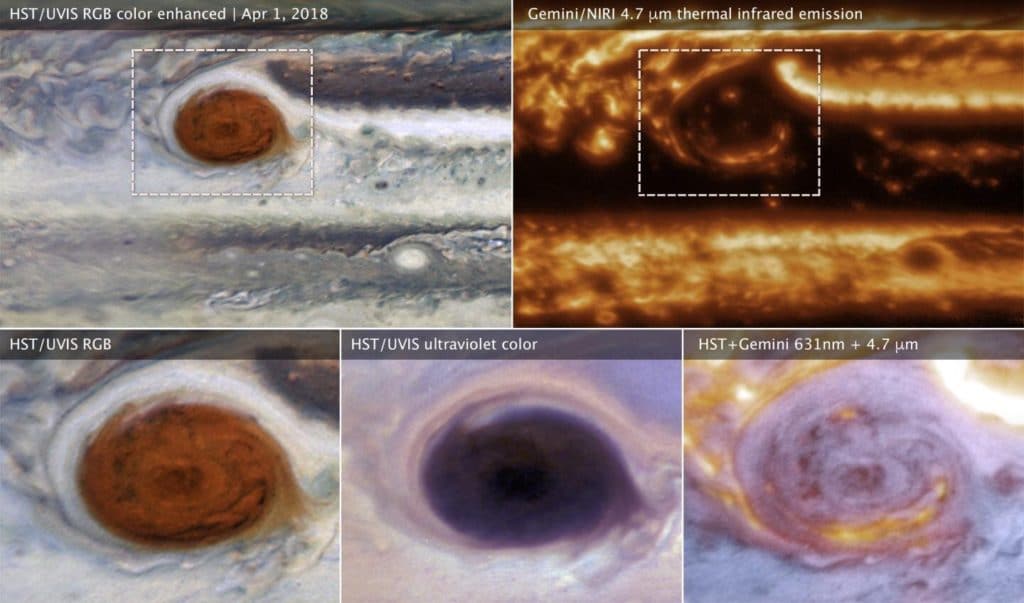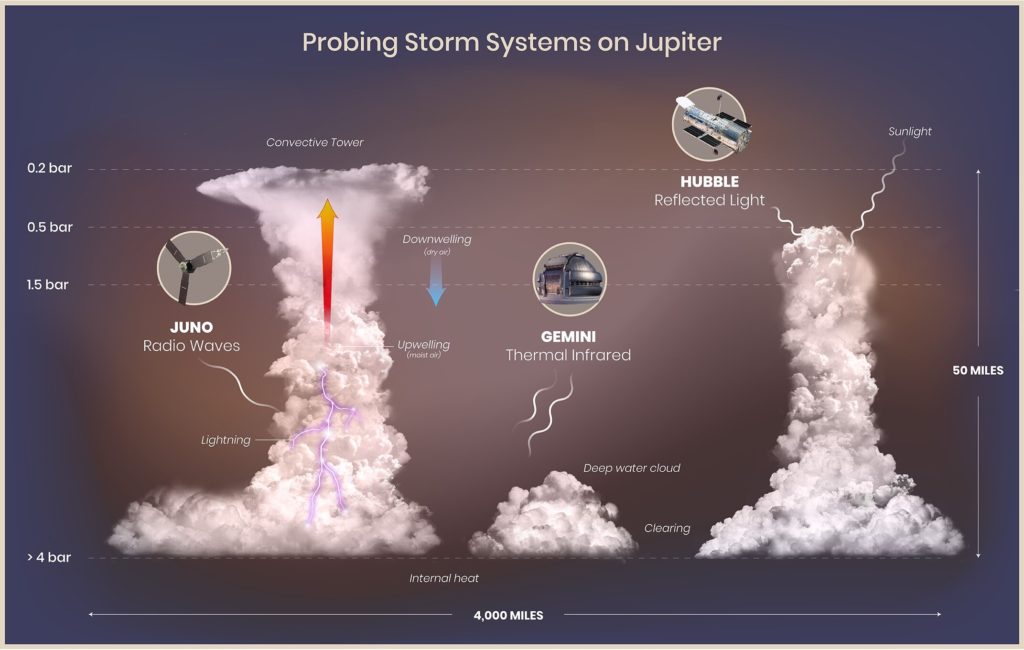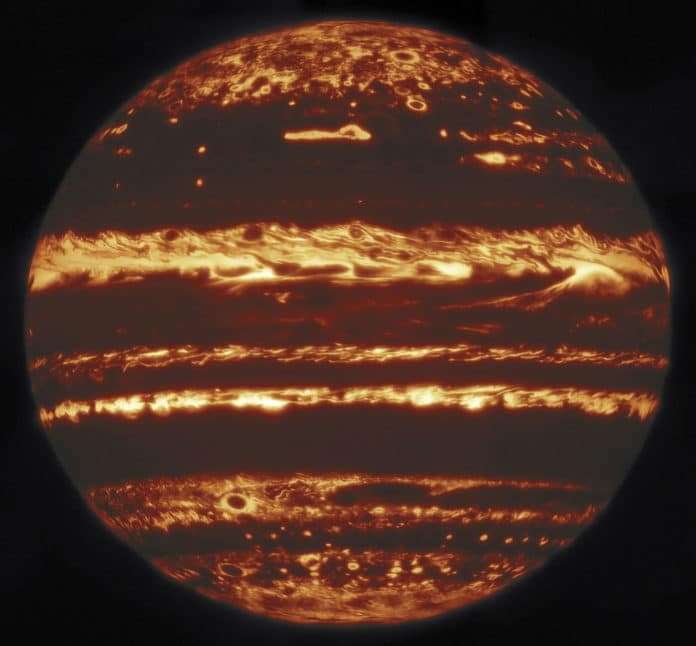Using a technique called Lucky imaging with the Gemini North telescope on Hawaii’s Maunakea, scientists obtained some of the highest resolution images of Jupiter ever. When combined with the Hubble and Juno observations, the images show lightning strikes, and some of the largest storm systems that create them, are formed in and around large convective cells over deep clouds of water ice and liquid.
These images also reveal that the dark spots on the great red spot are gaps in the cloud cover and not due to cloud color variations.
Michael Wong of UC Berkeley said, “The Gemini data were critical because they allowed us to probe deeply into Jupiter‘s clouds on a regular schedule. We used a potent technique called lucky imaging. With lucky imaging, a large number of very short exposure images are obtained, and only the sharpest images, when the Earth‘s atmosphere is briefly stable, are used. The result, in this case, is some of the sharpest infrared images of Jupiter ever obtained from the ground. These images rival the view from space.”
Three years of imaging observations using the international Gemini Observatory, a program of NSF’s NOIRLab, have probed deep into Jupiter’s cloud tops.
Gemini North’s Near-Infrared Imager (NIRI) offers astronomers a deep insight into Jupiter’s mighty storms as its longer-wavelength infrared light can pass through the thin haze but is obscured by thicker clouds high in Jupiter’s atmosphere. This makes a “jack-o-lantern”- like impact in the images where the warm, deep layers of Jupiter’s atmosphere shine through gaps in the planet’s thick cloud cover.
NASA’s Hubble Space Telescope and the ground-based Gemini Observatory in Hawaii have teamed up with the Juno spacecraft to probe the mightiest storms in the solar system. Both telescopes with Juno can observe Jupiter’s atmosphere as a system of winds, gases, heat, and weather phenomena, gives coverage and insight, not unlike the network of weather satellites meteorologists use to observe Earth.

During flyby by the Jupiter’s clouds, Juno detected radio signals created by powerful lightning flashes called sferics (short for atmospherics) and whistlers (so-called because of the whistle-like tone they cause on radio receivers).
Using Gemini and Hubble images at multiple wavelengths, scientists probed the cloud structure. They then combined three pieces of information and found the lightning strikes, and some of the largest storm systems that create them, are formed in and around large convective cells over deep clouds of water ice and liquid.
Wong said, “Scientists track lighting because it is a marker of convection, the turbulent mixing process that transports Jupiter’s internal heat up to the visible cloud tops.”
Juno detected the largest concentration of lightning came from a swirling storm called a “filamentary cyclone.” This filamentary cyclone later found to be a twisted collection of tall convective clouds with deep gaps offering glimpses to the water clouds far below.
“Ongoing studies of lightning sources will help us understand how convection on Jupiter is different from or similar to convection in the Earth’s atmosphere.”
While scanning the gas giant for gaps in cloud cover, Gemini spotted a telltale glow in the Great Red Spot, indicating a clear view down to deep, warmer atmospheric layers.
However, similar features have been found before on this red giant spot. Still, visible-light observation couldn’t distinguish between darker cloud material, and thinner cloud cover over Jupiter’s warm interior, so their nature remained a mystery.
This time, Gemini’s data has solved this mystery.

Where visible-light images from Hubble show a dark semicircle in the Great Red Spot, images taken by Gemini using infrared light reveals a bright arc lighting up the region. This infrared glow, from Jupiter’s internal heat, would have been blocked by thicker clouds but can pass through Jupiter’s hazy atmosphere unobscured. By seeing these features as bright infrared hotspots, Gemini confirms that they are gaps in the clouds. Even though earlier observations have seen dark features in the Great Red Spot, the rapidly swirling winds within it hid the true nature of these spots until the simultaneous Hubble and Gemini observations were conducted.
Wong said, “NIRI at Gemini North is the most effective way for the US and the international Gemini partnership investigators to get detailed maps of Jupiter at this wavelength.”
Andrew Stephens, the Gemini astronomer who led the observations, said, “At this resolution, the telescope could resolve the two headlights of a car in Miami, seen from New York City.”
Martin Still, an astronomy program director at the National Science Foundation, said, “These coordinated observations prove once again that ground-breaking astronomy is made possible by combining the capabilities of the Gemini telescopes with complimentary ground- and space-based facilities. The international Gemini Partnership provides open access to a powerful combination of large telescopes’ collecting area, flexible scheduling, and a broad selection of interchangeable instruments.”
Journal Reference:
- Michael H. Wong, High-resolution UV/Optical/IR Imaging of Jupiter in 2016–2019. DOI: 10.3847/1538-4365/ab775f
